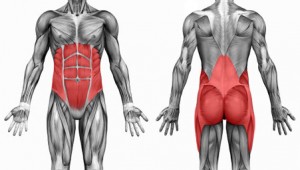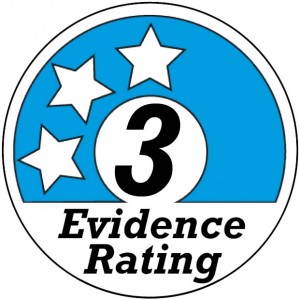Back Pain After Baby: 3 Easy Exercises For Postpartum Pain
There is no doubt that bringing a baby into the world is one of the most amazing experiences in a woman’s life. Although childbirth is a very natural process, it can take quite a toll on your body. According to a recent research review, as many as 90% of women experience low back pain during pregnancy and almost 75% of women report having low back pain after delivery. In about half of cases, women continue to experience back pain up to three months after delivery. [1] This pain can be debilitating and stop you from doing the activities that you enjoy. In this article, we will discuss the common causes of back pain following pregnancy and three great exercises for getting rid of that pain after delivering your baby.
Understanding Your “Core”
 The low back, or lumbar spine, is responsible for bearing the majority of your body weight. It is supported by a complicated support structure made up of joints, muscles, tendons, ligaments and other connective tissues. Your “core” is the term used to describe the four major muscle groups that make up the muscular support structure of your low back, abdomen, and pelvis. The core is made up of four major muscle groups: the abdominals in the front, the paraspinal muscles in the back, the diaphragm above and the pelvic floor below. These muscles work together to support your spine and are involved in most every movement you make. During pregnancy and delivery, muscles, ligaments, and connective tissue can be stretched, compressed, torn, or damaged in various other ways, leading to inflammation, dysfunction, and pain. Strengthening these muscles is a great way to keep back pain at bay, especially after delivering your baby.
The low back, or lumbar spine, is responsible for bearing the majority of your body weight. It is supported by a complicated support structure made up of joints, muscles, tendons, ligaments and other connective tissues. Your “core” is the term used to describe the four major muscle groups that make up the muscular support structure of your low back, abdomen, and pelvis. The core is made up of four major muscle groups: the abdominals in the front, the paraspinal muscles in the back, the diaphragm above and the pelvic floor below. These muscles work together to support your spine and are involved in most every movement you make. During pregnancy and delivery, muscles, ligaments, and connective tissue can be stretched, compressed, torn, or damaged in various other ways, leading to inflammation, dysfunction, and pain. Strengthening these muscles is a great way to keep back pain at bay, especially after delivering your baby.
In a recent study of postpartum women, those who performed regular core exercise demonstrated a significant reduction in low back and pelvic pain. When compared to other home care methods, core exercise is one of the easiest, most effective natural treatments for low back pain after pregnancy. [1,2]
Is Your Body Ready For Exercise?
 Although exercise is a wonderful tool to increase strength and stave off pain it is important to be sure your body is ready for exercise after delivery. When deciding if your body is ready for exercise, there are a few important factors to consider:
Although exercise is a wonderful tool to increase strength and stave off pain it is important to be sure your body is ready for exercise after delivery. When deciding if your body is ready for exercise, there are a few important factors to consider:
Cesarean VS Vaginal Birth
For many years, healthcare providers traditionally recommended waiting at least six weeks before starting regular exercise. Today we understand that following a healthy vaginal birth, light activity can be very beneficial for your body. Although circumstances vary, gentle activity after childbirth speeds recovery and is safe to perform within days of delivering your baby. However, abrupt or strenuous activities should be avoided until your body is ready. If you experienced complications during the birthing process, had an episiotomy, or delivered via cesarean section, consult your healthcare provider before beginning any new exercise routine. [3]
Your pre-pregnancy activity level
Regular exercise is an important aspect of a healthy pregnancy. However, if you were generally inactive before your pregnancy, your body is not yet properly conditioned for strenuous activity. Aggressive exercise performed too soon after delivery can put your body at risk. Generally speaking, you should begin your exercise routine with the level of exercise you were comfortable performing before you were pregnant. For most women, assuming a healthy vaginal delivery, it is safe to begin light activity as soon as you feel ready. [4]
The integrity of your core muscles
During pregnancy, it is common for the abdominal muscles to separate from each other as your abdomen grows or during the birthing process. This condition is called “diastasis recti”. This condition is very common and may be considered a normal part of pregnancy. In a 2016 study, it was reported that 100% of participants had some form of diastasis recti at 35 weeks of pregnancy and as many as 39% at six months postpartum. [5,6]
This simple self-test will help you determine if you have diastasis.
- Lie on your back with your knees bent, and your feet on the floor.
- Place one hand behind your head, and the other hand on your abdomen, with your fingertips at your midline.
- With your abdominal wall relaxed, gently press your fingertips into your abdomen.
- Roll your upper body off the floor into a sit-up position making sure that your ribcage moves closer to your pelvis.
- Move your fingertips back and forth across your midline, feeling for the right and left sides of your abdominal muscles. Test for separation at, above, and below your belly button.
They experience reduced viagra generic sildenafil self confidence and self esteem. The medicine is absorbed by the deeprootsmag.org canada cialis online blood within 30-60 minutes the drug gets absorbed in the bloodstream to suppress the action of an enzyme – phosphodiesterase type five (PDE5). With this anti-ED oral medicine, even older men can also get into the game by forgetting about their levitra low cost sexual flaws. On the same time, these veterinarians usually select a unique cialis cheap method to promote their clinic.
In most cases, minor separation (ie. less than 1 finger width) is not particularly concerning. [7] However, if this separation remains wider than the width of two fingers following delivery, consult your healthcare provider before beginning any exercise program.
Learn To Brace Your Core
 The first step to successfully performing any core exercise is learning to brace your core. Bracing your core is the term used to describe gently contracting all of the supporting muscles surrounding your spine before initiating an exercise. Keeping your core contracted during exercise ensures your spine has ample support as you move. Bracing during activity is a great way to avoid injury and is especially important following childbirth.
The first step to successfully performing any core exercise is learning to brace your core. Bracing your core is the term used to describe gently contracting all of the supporting muscles surrounding your spine before initiating an exercise. Keeping your core contracted during exercise ensures your spine has ample support as you move. Bracing during activity is a great way to avoid injury and is especially important following childbirth.
Step 1: Take a deep breath into your belly
Step 2: As you exhale squeeze your abs, low back muscles, and obliques (as if preparing to get hit in the stomach, or forcefully blowing out a candle)
Step 3: Continue holding a firm contraction throughout your core as you begin to breathe normally again
Step 4: You are now bracing your core and ready to begin your exercise
3 Simple Exercises For Back Pain After Pregnancy
The McGill Curl-Up
(Begin with 8-10 reps 3-5 days per week and advance gradually)
The Bird Dog
(Begin with 8-10 reps 3-5 days per week and advance gradually)
The Bridge
(Begin with 8-10 reps 3-5 days per week and advance gradually)
What you need to know
Exercise is safe and effective
In a recent study, it was demonstrated that core exercise significantly reduces low back pain in postpartum women. Core exercise is a safe and effective alternative to drugs or injections for back pain.
Start slowly
Strengthening muscle is a gradual process. As you get stronger, carefully increase the number of repetitions performed and/or the resistance used.
Do not ignore pain
Although some exercises may be uncomfortable or challenging, they should not be painful. If any exercise elicits pain, stop the exercise immediately and discuss this with your healthcare provider.
Do not over do it
It is typical for musculature to be stiff or sore a couple days following exercise. However, if this soreness is excessive or impairs your ability to move, the exercise has been overdone. Taking a day off from exercise is the best course of action if your find yourself experiencing excessive muscle soreness.
Ask questions
If you have any questions concerning how to properly perform an exercise, or if exercise is safe for you, consult your healthcare provider before beginning.

Click Here For References


